 |
| |
MI6 looks back at the life and career of Welsh
actor Desmond Llewelyn - best known for his role
as MI6 Quartermaster 'Q'...
|
|
Desmond Llewelyn Biography
31st January 2009
Desmond Wilkinson Llewelyn
was born in Newport, Wales, on September 12th 1914. The
son of an engineer Ivor, and his wife Mia Llewelyn, Desmond
grew up in a wealthy family environment. His grandfather
Llewlyn Llewelyn started out in mining and rose to be a
colliery owner and High Sheriff of Monmouthshire. His son
Ivor, married his cousin Mia when he was 30. The pair had
two children, Desmond and the younger daughter Noreen.
At age 9, Desmond attended the Priory preparatory boarding school before enrolling at Radley College, a Church of England boy's school in Oxfordshire. His mother was convinced not to send her son to Harrow by the headmaster at Radley. At school Llewelyn was no academic - preferring sports, Desmond's talent initially emerged on the Rugby field.
In his youth he would work backstage at
a local theatre - hauling set and assisting actors - before
he developed a love for on-stage work.
A friend from the
theatre convinced Desmond to try his hand at the thespian
arts and he never looked back. Llewelyn initially joined
the Little Theatre Company in Southerland, prior his time
in Oxfordshire, where he was involved in the Forsyth Players,
both on stage and off. |
|
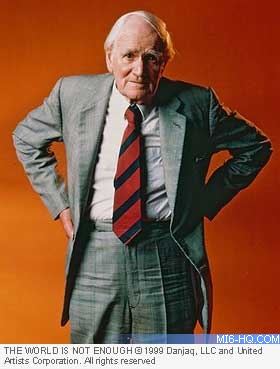
Datastream
Name:
Desmond Wilkinson Llewelyn
Date of Birth: 12th September 1914
Date of Death: 19th December 1999
Active career: 1938-1999
Bond films: 17 |
|
Before descending on the often rocky path
to becoming an actor, Llewelyn considered entering the priesthood.
He experienced a weekend retreat at a local ministry and quickly
discovered that a clergy's life would not suit him. Desmond grew
up to be a striking 6'3" man with a gregarious personality
and easily charmed the women he met - somewhat of a clash with
his original intent to join the priesthood.
His father, who held a "respectable" job, was at first resistant to his son - now a young man - wishing to enter the entertainment industry. His uncle, a detective in the police, saw to it that Llewelyn take the police recruitment test. The would-be performer failed the eye-exam that went along with the test and luckily for Desmond, was not welcome onto the Bill. Finally, in the mid 1930s, Desmond's parents reluctantly allowed him journey to London to audition for The Royal Academy of Dramatic Arts.
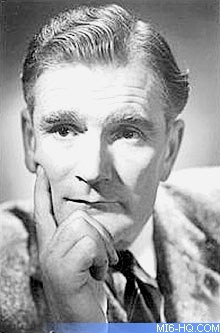 |
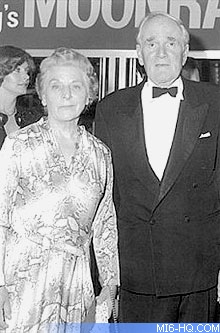 |
Whilst in London, Llewelyn gained the opportunity
to work on a couple of small television shows, giving him a taste
of his career to come. On 16th May 1938, Desmond married his
high school girlfriend Pamela Pantlin and the pair remained married
for 60 years, until his death. It was much later revealed
that Pamela had to coax Desmond into the marriage. He initially
protested against the union as he felt he would be unable to
fiscally support Pamela. Her response to this was to "bugger
the money" and to go through with their vows.
Shortly after Llewelyn was
accepted into RADA, the Second World War saw a halt in
his acting career and Desmond was quickly commissioned into
the British army, at the respectable rank of Second Lieutenant.
He served with the Royal Welch Fusillers regiment - part
of the Prince of Wales' Division with a history that
dates back to 1689. With his regiment, Llewelyn saw battle
in France in the early years of the war. Here he faced
a
division of German Panzer for two days without rest.
When the British forces in the area were overpowered, Llewelyn
was taken prisoner of war and spent five years - to the
day - at a variety of prison camps. He recalled later
that
he felt he and his fellow British Army officers were
treated fairly, even when caught in the midst of a planned
escape!
When peace was declared Llewelyn was able to return to Britain, his mind still closely set on becoming an actor. Meanwhile, with family inheritance he was able to buy a house for himself and Pamela in Chelsea and later, a grander one in Battle. Shortly after this the pair had two sons, Ivor and Justin - the latter will often make appearances at James Bond events in memory of his father.
|
|
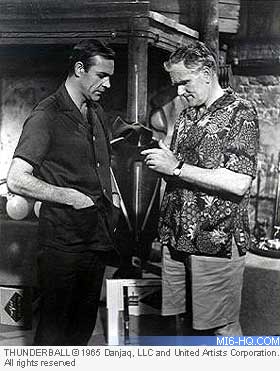
Above: Desmond Llewelyn as 'Q', equipping James Bond mid-mission
in the Bahamas... |
In 1946 Desmond was cast in a screen adaptation of Shakespeare's "A Midsummer Night's Dream", directed by and starring Sir Robert Atkins. Whilst this and so much of his early work is often forgotten, Desmond's career gained steady momentum in UK television and occasionally films. In the 1950s Llewelyn performed in the mini-series "My Wife Jaqueline" as well as guest starred in popular shows of the time - including Richard Greene's "Robin Hood" and the sci-fi flick "The Invisible Man". He spent a limited amount of time on the stage, including a small role in a production with Laurence Olivier - but most of Desmond's work came in the form of screen acting.
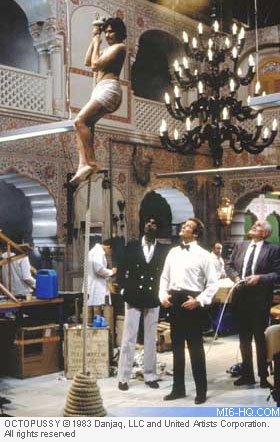
Above: Q gives 007 a demonstration
of the newest field equipment for Station I, India... |
|
On the big-screen Llewelyn
was cast as '77 Jones in World War II drama "They
Were Not Divided" (1950). On this production he met
and worked closely with Terence
Young, the film's director. When Young was brought
on to helm the new spy series James Bond, he invited Llewelyn
to audition for the role of the MI6 armourer, Major
Boothroyd.
Desmond Llewelyn first performed the iconic
role of the Quartermaster on the set of M's
office for the 007 adventure, "From
Russia With Love" (1963). Although it was not
until "Thunderball" that
his character was dubbed 'Q' by screenwriter Richard Maibaum,
Desmond's learned character of the gadget boffin was a
strong and memorable moment of the second Bond adventure.
The character hails back to Ian Fleming's armourer who appears in the novel "Dr No" - kitting out 007 with his famed Walther PPK. The name Boothroyd was taken from a Glasgow guns expert, Geoffrey Boothroyd who wrote a letter to Mr. Fleming, "I like everything about your James Bond except his deplorable taste in weapons. A Beretta 22 is utterly useless as well as being a lady's gun - and not a very nice lady at that!"
|
The role of Q was one that required hours of preparation for Desmond. Throughout his career on the Bond pictures - appearing in 18 out of 19 consecutive adventures - Llewelyn would battle with the outrageously complicated dialogue he was required to deliver. It reportedly took him many hours of study in order to be able to confidently deliver the lines as his character. Desmond's dedication to the role was impressive and gadgetry, real or imagined, was something he never indulged in outside of his work on the Bond pictures.
On the set of the Bond films Guy
Hamilton developed the much-loved rapport between Q and 007.
Hamilton - the director of three outings - suggested
to Llewelyn that his character should be skeptical of 007's
hero status. On the set of the third Bond outing "Goldfinger",
Boothroyd's character comes into its own. "The director
said, 'Everyone loves Bond, except for you. You hate him. You
don't think he appreciates you. Or your equipment. He doesn't
respect you. You're always saving his life, and he never says
thank you,'" Llewelyn
recalled.
With the commercial success
of "Goldfinger",
Llewelyn and his fellow Bond filmmakers were flung into
stardom. His scenes quickly became something of a feature
of each film and Q became a favourite of Bond fan's. His
scenes were always eagerly awaited by cinemagoers.
Between 1960 and 1968, Llewelyn appeared
in the long running crime-thriller "Dixon of Dock
Green". He starred in three episodes of the TV drama
as three different characters.
The same year he was cast
in another Albert
R. Broccoli production - the musical adaptation of
Fleming's classic children's story, "Chitty Chitty
Bang Bang". In the Dick Van Dyke-lead adventure, Desmond
plays the local scrap merchant Mr. Coggins who sells the
family their classic motorcar.
Right: Desmond Llewelyn
in Sweden to promote "Octopussy" - here he
demonstrates Bond's piton
gun from "Diamonds Are Forever".. |
|
|
When Roger Moore was
ushered in as James Bond in 1973's "Live
and Let Die", Q was pushed out - albeit briefly. Between
1971 and 1974 Desmond was performing as one of the regulars in
English drama "Follyfoot". The show ran for three seasons
and Llewelyn's character of Geoffrey Maddocks appeared in all
but two. With Llewelyn busy with his regular "Follyfoot" commitments,
the Bond producers took the opportunity to experiment with a
different form of Bond. Whilst "Live and Let Die" proved
a successful introduction for Moore, there was definitely something
missing.
Llewelyn teamed up with Roger Moore on the set of the next Bond film, "The Man With The Golden Gun"; the pair were old acquaintances and had worked together on UK television in years prior. Sir Roger Moore, who was renowned for his practical jokes, reportedly sabotaged Desmond's scripts with extra pages of nonsense. The Quartermaster would diligently rehearse throughout all his spare time, struggling to get the overly complicated jargon word-perfect for shooting. Despite the jokes on-set Moore and Llewelyn worked splendidly together for six James Bond adventures, before due course saw Timothy Dalton land the role.
Right: Q installs a microchip in the priceless Fabergé Egg... |
|
|
In 1981, Llewelyn appeared in as Sir Danvers
Carew in a TV adaptation of the classic Robert Louis Stevenson
horror "Dr. Jekyll and Mr. Hyde". Desmond played opposite
Diana Dors and David Hemmings - who took the title role. During
this period Desmond also appeared in the life-story of train-robber
Ronald Briggs, "Prisoner of Rio". Briggs was played
by Paul Freeman and Llewelyn worked with a supporting cast that
included stage and screen veteran Steven
Berkoff and Peter Firth (who would later appear in his own
spy thriller, BBC's "Spooks").
By the mid-1980s Desmond Llewelyn's ties to
Bond were not merely the productions themselves. He appeared
in a variety of advertisements for gadget-like products, with
their manufacturers hoping to ride on the success of the Quartermaster's
character. Over the years Desmond has advertised the CD-rom,
a theme-park ride, watches and Llewelyn even appeared in screen
adverts for the '90s James Bond
video games.
In 1989's "Licence to Kill" the MI6 Quartermaster gained his biggest role yet. When 007 goes rogue in order to avenge the brutally masticated Felix Leiter, Llewelyn's character joins him in the field - Desmond was welcomed on location with the cast and crew of "Licence to Kill". When the film went to preview screenings for London's press, his additional screen-time impressed everyone lucky enough to attend.
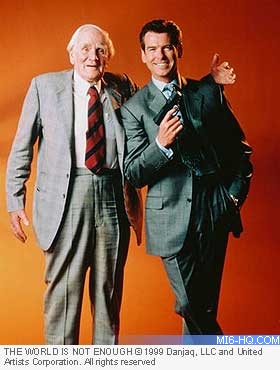 |
|
At that time Llewelyn noted
that his extended role in "Licence To Kill" was
the only time he made any real money out of Bond. Llewelyn
never shared the spoils of having a film contract, nor
did he receive bonuses based on the series' success. Llewelyn
was a loyal and long-standing member of the Bond family
and this was clearly reward enough for the gadget-master.
"The World Is Not Enough" saw Q hand over to R (John Cleese) in preparation for Llewelyn's retirement from the Bond films. It was to be his last Bond film, whether he truly intended this or not. Prior to the release of "The World Is Not Enough", Llewelyn was quoted to say he intended to continue with the 007 pictures, "so long as EON want me and The Almighty doesn't."
Left: Brosnan and Llewelyn promote Q's final Bond film, "The World Is Not Enough"... |
Throughout his life Llewelyn was an advocate for young people's access to cinema. He was an exponent of, if not driving force behind some of the re-screenings of his classic Bond pictures. He declared his favourite Bond films to be "Octopussy" and "Licence To Kill", as both gave him the opportunity to get on location and extend the role of Q to a new dimension.
On the 19th of December 1999, exactly a month
after the opening of "The World Is Not Enough", Llewelyn
was driving home from a book-signing of "Q: The Biography
of Desmond Llewelyn" when
his vehicle collided with another on the A27 in East Sussex.
The other driver was seriously injured and Desmond passed
away in hospital a few hours later - he was 85. At his memorial
service,
friends and family from throughout his life and career appeared
to pay tribute. His sons spoke as well as many of his Bond colleagues,
including Roger Moore, who delivered the eulogy.
Related Articles
 Biography
Biography
 Q
Q
 Licence to Kill - Premiere and Press
Licence to Kill - Premiere and Press
 The World Is Not Enough - Premiere and Press
The World Is Not Enough - Premiere and Press